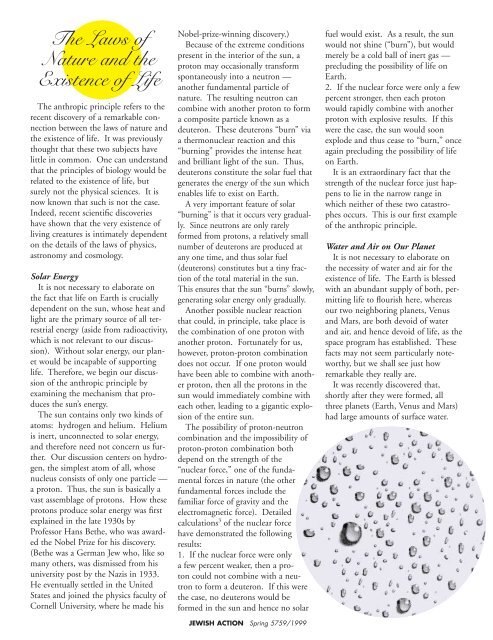The Anthropic Principle
The Anthropic Principle
The Anthropic Principle
You also want an ePaper? Increase the reach of your titles
YUMPU automatically turns print PDFs into web optimized ePapers that Google loves.
<strong>The</strong> Laws of<br />
Nature and the<br />
Existence of Life<br />
<strong>The</strong> anthropic principle refers to the<br />
recent discovery of a remarkable connection<br />
between the laws of nature and<br />
the existence of life. It was previously<br />
thought that these two subjects have<br />
little in common. One can understand<br />
that the principles of biology would be<br />
related to the existence of life, but<br />
surely not the physical sciences. It is<br />
now known that such is not the case.<br />
Indeed, recent scientific discoveries<br />
have shown that the very existence of<br />
living creatures is intimately dependent<br />
on the details of the laws of physics,<br />
astronomy and cosmology.<br />
Solar Energy<br />
It is not necessary to elaborate on<br />
the fact that life on Earth is crucially<br />
dependent on the sun, whose heat and<br />
light are the primary source of all terrestrial<br />
energy (aside from radioactivity,<br />
which is not relevant to our discussion).<br />
Without solar energy, our planet<br />
would be incapable of supporting<br />
life. <strong>The</strong>refore, we begin our discussion<br />
of the anthropic principle by<br />
examining the mechanism that produces<br />
the sun’s energy.<br />
<strong>The</strong> sun contains only two kinds of<br />
atoms: hydrogen and helium. Helium<br />
is inert, unconnected to solar energy,<br />
and therefore need not concern us further.<br />
Our discussion centers on hydrogen,<br />
the simplest atom of all, whose<br />
nucleus consists of only one particle —<br />
a proton. Thus, the sun is basically a<br />
vast assemblage of protons. How these<br />
protons produce solar energy was first<br />
explained in the late 1930s by<br />
Professor Hans Bethe, who was awarded<br />
the Nobel Prize for his discovery.<br />
(Bethe was a German Jew who, like so<br />
many others, was dismissed from his<br />
university post by the Nazis in 1933.<br />
He eventually settled in the United<br />
States and joined the physics faculty of<br />
Cornell University, where he made his<br />
Nobel-prize-winning discovery.)<br />
Because of the extreme conditions<br />
present in the interior of the sun, a<br />
proton may occasionally transform<br />
spontaneously into a neutron —<br />
another fundamental particle of<br />
nature. <strong>The</strong> resulting neutron can<br />
combine with another proton to form<br />
a composite particle known as a<br />
deuteron. <strong>The</strong>se deuterons “burn” via<br />
a thermonuclear reaction and this<br />
“burning” provides the intense heat<br />
and brilliant light of the sun. Thus,<br />
deuterons constitute the solar fuel that<br />
generates the energy of the sun which<br />
enables life to exist on Earth.<br />
A very important feature of solar<br />
“burning” is that it occurs very gradually.<br />
Since neutrons are only rarely<br />
formed from protons, a relatively small<br />
number of deuterons are produced at<br />
any one time, and thus solar fuel<br />
(deuterons) constitutes but a tiny fraction<br />
of the total material in the sun.<br />
This ensures that the sun “burns” slowly,<br />
generating solar energy only gradually.<br />
Another possible nuclear reaction<br />
that could, in principle, take place is<br />
the combination of one proton with<br />
another proton. Fortunately for us,<br />
however, proton-proton combination<br />
does not occur. If one proton would<br />
have been able to combine with another<br />
proton, then all the protons in the<br />
sun would immediately combine with<br />
each other, leading to a gigantic explosion<br />
of the entire sun.<br />
<strong>The</strong> possibility of proton-neutron<br />
combination and the impossibility of<br />
proton-proton combination both<br />
depend on the strength of the<br />
“nuclear force,” one of the fundamental<br />
forces in nature (the other<br />
fundamental forces include the<br />
familiar force of gravity and the<br />
electromagnetic force). Detailed<br />
calculations 3 of the nuclear force<br />
have demonstrated the following<br />
results:<br />
1. If the nuclear force were only<br />
a few percent weaker, then a proton<br />
could not combine with a neutron<br />
to form a deuteron. If this were<br />
the case, no deuterons would be<br />
formed in the sun and hence no solar<br />
JEWISH ACTION Spring 5759/1999<br />
fuel would exist. As a result, the sun<br />
would not shine (“burn”), but would<br />
merely be a cold ball of inert gas —<br />
precluding the possibility of life on<br />
Earth.<br />
2. If the nuclear force were only a few<br />
percent stronger, then each proton<br />
would rapidly combine with another<br />
proton with explosive results. If this<br />
were the case, the sun would soon<br />
explode and thus cease to “burn,” once<br />
again precluding the possibility of life<br />
on Earth.<br />
It is an extraordinary fact that the<br />
strength of the nuclear force just happens<br />
to lie in the narrow range in<br />
which neither of these two catastrophes<br />
occurs. This is our first example<br />
of the anthropic principle.<br />
Water and Air on Our Planet<br />
It is not necessary to elaborate on<br />
the necessity of water and air for the<br />
existence of life. <strong>The</strong> Earth is blessed<br />
with an abundant supply of both, permitting<br />
life to flourish here, whereas<br />
our two neighboring planets, Venus<br />
and Mars, are both devoid of water<br />
and air, and hence devoid of life, as the<br />
space program has established. <strong>The</strong>se<br />
facts may not seem particularly noteworthy,<br />
but we shall see just how<br />
remarkable they really are.<br />
It was recently discovered that,<br />
shortly after they were formed, all<br />
three planets (Earth, Venus and Mars)<br />
had large amounts of surface water.
















